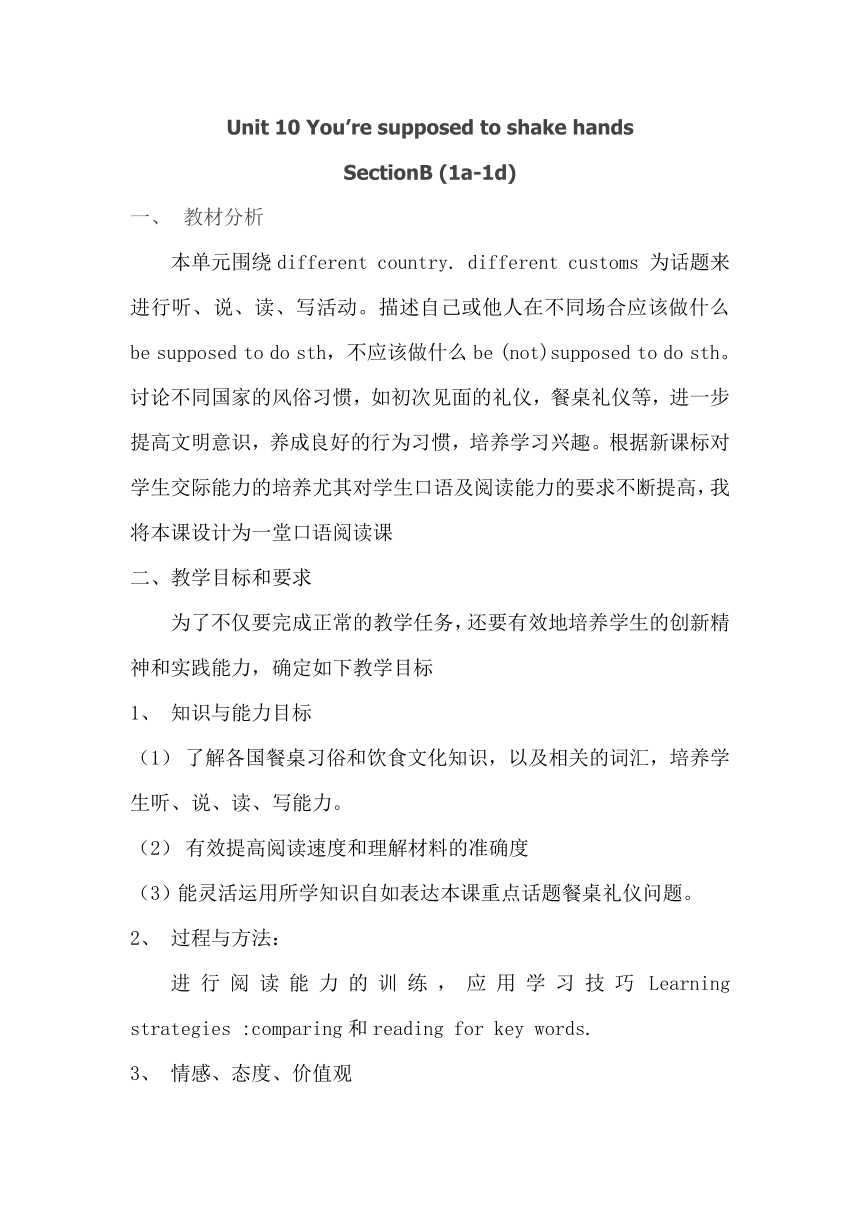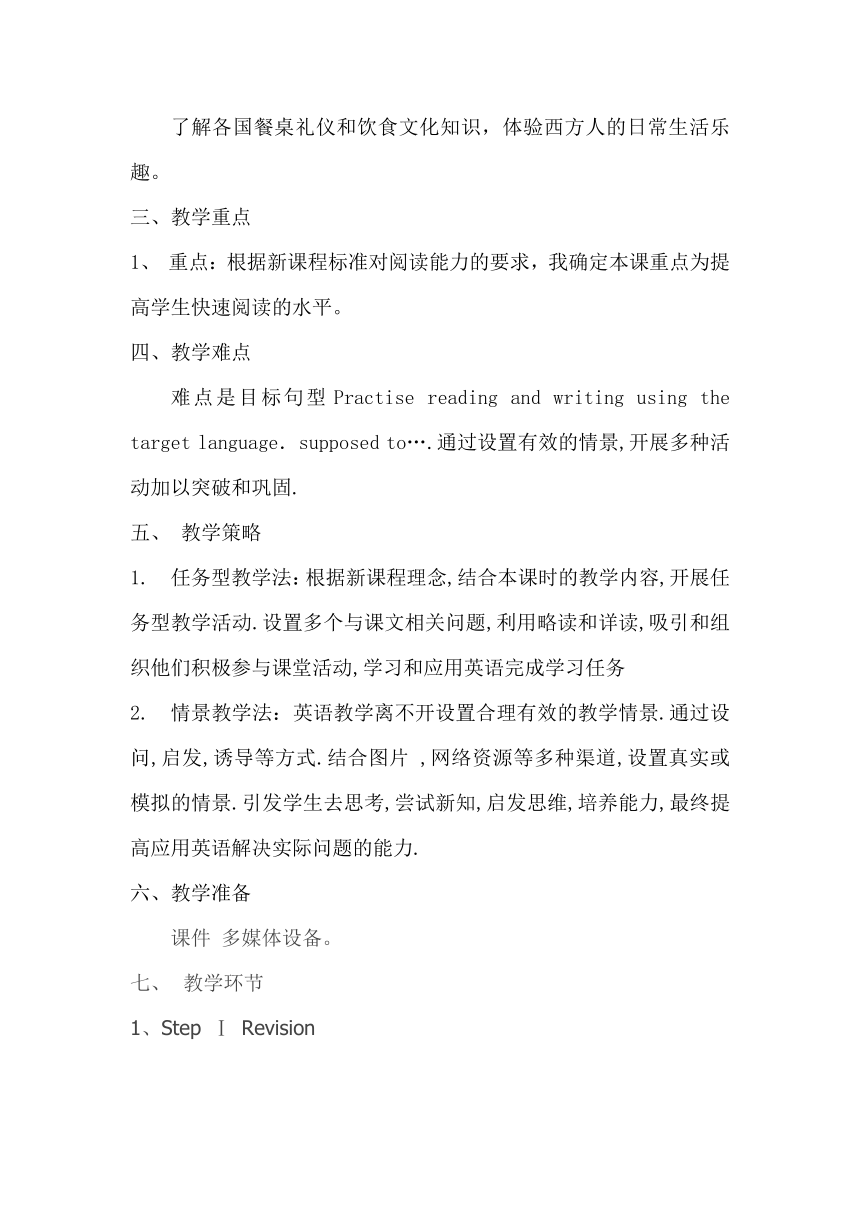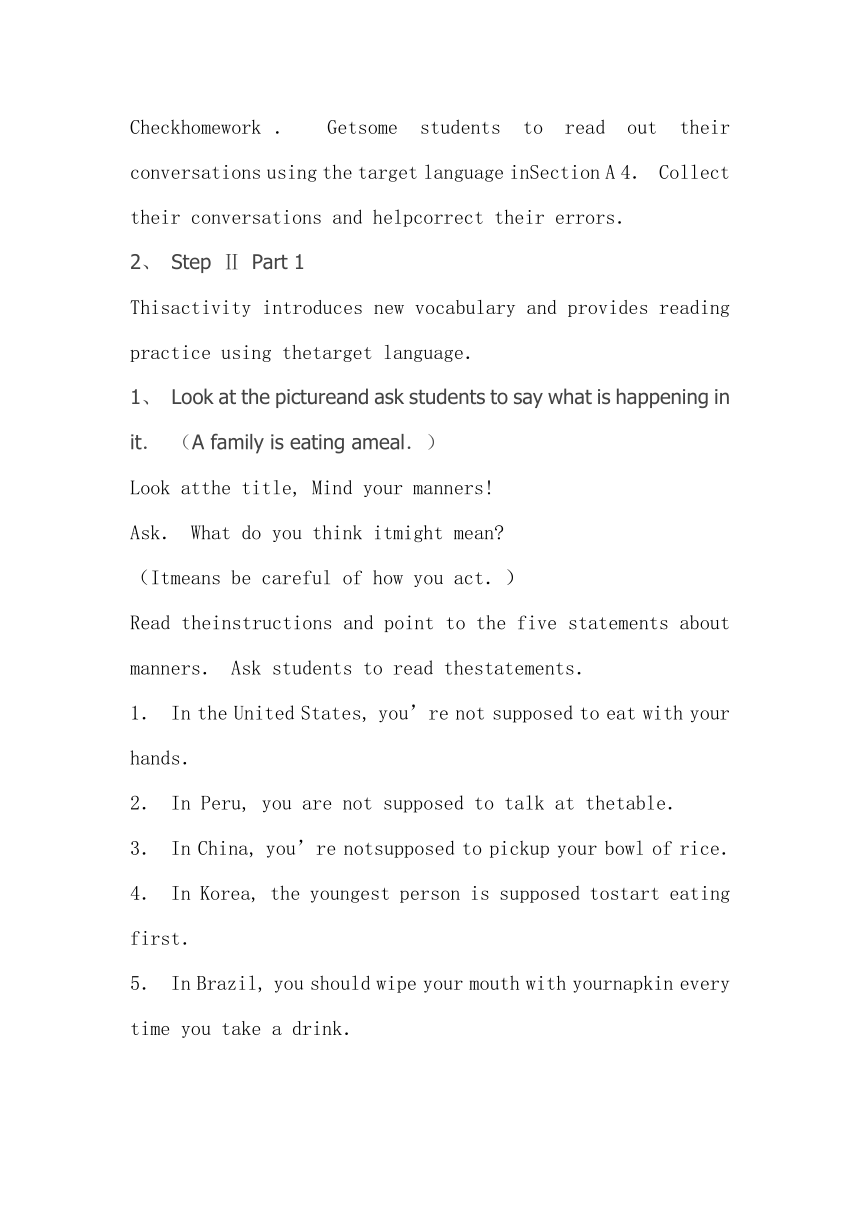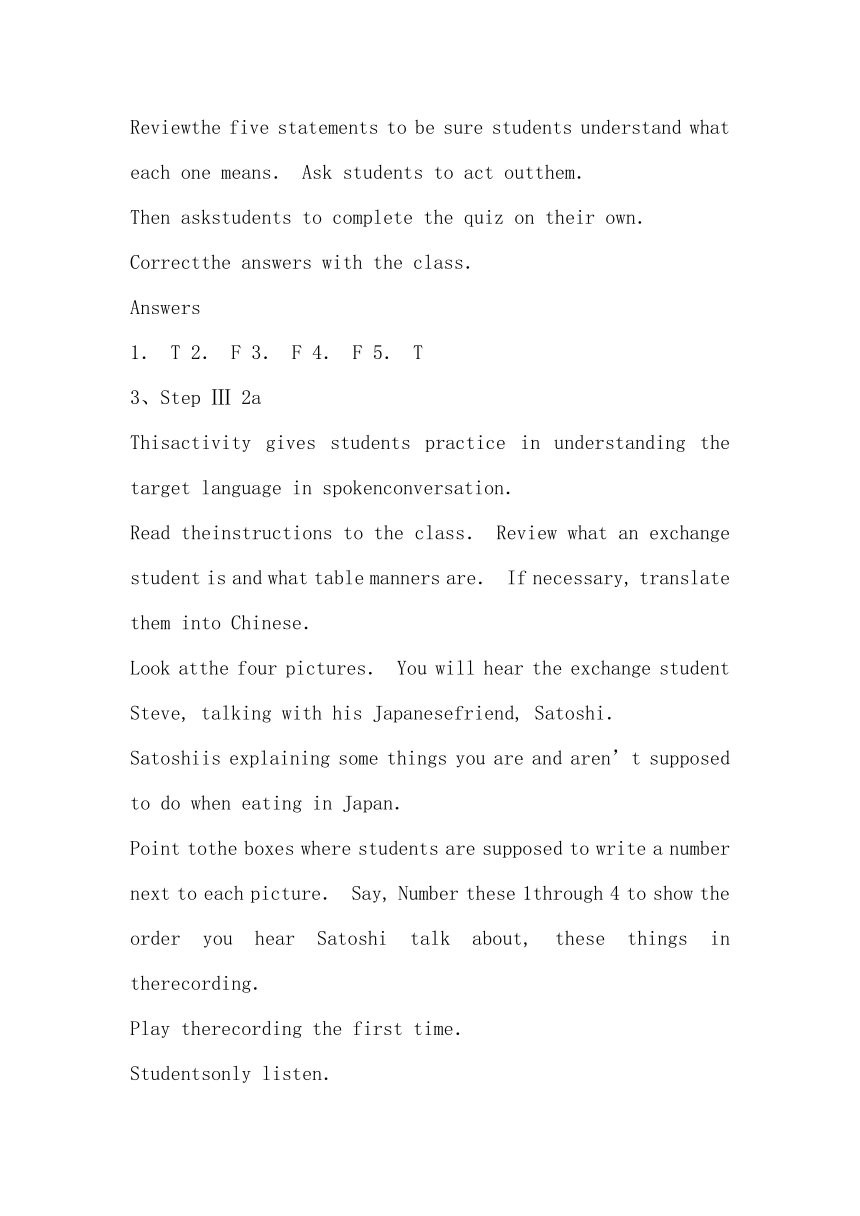人教版九年级全册英语 Unit10 You are suppoed to shake hands. SectionB 1a-1d 教案
文档属性
| 名称 | 人教版九年级全册英语 Unit10 You are suppoed to shake hands. SectionB 1a-1d 教案 |  | |
| 格式 | doc | ||
| 文件大小 | 50.0KB | ||
| 资源类型 | 教案 | ||
| 版本资源 | 人教新目标(Go for it)版 | ||
| 科目 | 英语 | ||
| 更新时间 | 2022-12-26 19:32:47 | ||
图片预览




文档简介
Unit 10 You’re supposed to shake hands
SectionB (1a-1d)
一、 教材分析
本单元围绕different country. different customs 为话题来进行听、说、读、写活动。描述自己或他人在不同场合应该做什么be supposed to do sth,不应该做什么be (not)supposed to do sth。讨论不同国家的风俗习惯,如初次见面的礼仪,餐桌礼仪等,进一步提高文明意识,养成良好的行为习惯,培养学习兴趣。根据新课标对学生交际能力的培养尤其对学生口语及阅读能力的要求不断提高,我将本课设计为一堂口语阅读课
二、教学目标和要求
为了不仅要完成正常的教学任务,还要有效地培养学生的创新精神和实践能力,确定如下教学目标
1、 知识与能力目标
(1) 了解各国餐桌习俗和饮食文化知识,以及相关的词汇,培养学生听、说、读、写能力。
(2) 有效提高阅读速度和理解材料的准确度
(3) 能灵活运用所学知识自如表达本课重点话题餐桌礼仪问题。
2、 过程与方法:
进行阅读能力的训练,应用学习技巧Learning strategies :comparing和reading for key words.
3、 情感、态度、价值观
了解各国餐桌礼仪和饮食文化知识,体验西方人的日常生活乐趣。
三、教学重点
1、 重点:根据新课程标准对阅读能力的要求,我确定本课重点为提高学生快速阅读的水平。
四、教学难点
难点是目标句型Practise reading and writing using the target language.supposed to….通过设置有效的情景,开展多种活动加以突破和巩固.
五、 教学策略
1. 任务型教学法:根据新课程理念,结合本课时的教学内容,开展任务型教学活动.设置多个与课文相关问题,利用略读和详读,吸引和组织他们积极参与课堂活动,学习和应用英语完成学习任务
2. 情景教学法:英语教学离不开设置合理有效的教学情景.通过设问,启发,诱导等方式.结合图片 ,网络资源等多种渠道,设置真实或模拟的情景.引发学生去思考,尝试新知,启发思维,培养能力,最终提高应用英语解决实际问题的能力.
六、教学准备
课件 多媒体设备。
七、 教学环节
1、Step Ⅰ Revision
Checkhomework. Getsome students to read out their conversations using the target language inSection A 4. Collect their conversations and helpcorrect their errors.
2、 Step Ⅱ Part 1
Thisactivity introduces new vocabulary and provides reading practice using thetarget language.
1、 Look at the pictureand ask students to say what is happening in it. (A family is eating ameal.)
Look atthe title, Mind your manners!
Ask. What do you think itmight mean
(Itmeans be careful of how you act.)
Read theinstructions and point to the five statements about manners. Ask students to read thestatements.
1. In the United States, you’re not supposed to eat with your hands.
2. In Peru, you are not supposed to talk at thetable.
3. In China, you’re notsupposed to pickup your bowl of rice.
4. In Korea, the youngest person is supposed tostart eating first.
5. In Brazil, you should wipe your mouth with yournapkin every time you take a drink.
Reviewthe five statements to be sure students understand what each one means. Ask students to act outthem.
Then askstudents to complete the quiz on their own.
Correctthe answers with the class.
Answers
1. T 2. F 3. F 4. F 5. T
3、Step Ⅲ 2a
Thisactivity gives students practice in understanding the target language in spokenconversation.
Read theinstructions to the class. Review what an exchange student is and what table manners are. If necessary, translate them into Chinese.
Look atthe four pictures. You will hear the exchange student Steve, talking with his Japanesefriend, Satoshi.
Satoshiis explaining some things you are and aren’t supposed to do when eating in Japan.
Point tothe boxes where students are supposed to write a number next to each picture. Say, Number these 1through 4 to show the order you hear Satoshi talk about, these things in therecording.
Play therecording the first time.
Studentsonly listen.
Play therecording a second time. As they listen to the recording this time, let students number thepictures.
Correctthe answers with the class.
Answers
Thepictures should be numbered in the following order:
2 1 4 3
Tapescript
Satoshi:You must be really excited about leaving for Japan tomorrow, Steve!
Steve:Yeah, I am.But I’m a little nervous, too.
Satoshi:Nervous about what
Steve:Well, for one thing, I don’t know how to use chopsticks very well…and Idon’t know how to behave at the dinner table.
Satoshi:Oh, I see. Icould give you a little lesson on Japanese table manners if you like.
Steve:Really That would be great!
Satoshi:Hmmmm. Let mesee. One difference is that sometimes it’s polite to make noise when you’re eating. Especially when you’re eating noodles. It shows that you like the food.
Steve:Really That’sinteresting. In the United States you’re not supposed to do that.
Satoshi:Yeah, I know.OK. so here are some chopstick rules: it’s rude to stick your chopsticks into your food. And you shouldn’t point at anyone with yourchopsticks.
Steve:Oh, OK. I won’t,
Satoshi:And also, this isn’t about table manners exactly, but you should know that you aren’t supposed to eat or drink while walking down the street.
Steve:Huh.
Satoshi:Oh, and the most important thing you need to know is that you’re not supposed to talkwhen you’re eating dinner. Onlyparents are allowed to talk at the dinner table.Children are not allowed to speak.
Steve:Wow! That’s…that’s unusual!
Satoshi:I’m just kidding! Boy, you’re really gullible, Steve!
4、Step Ⅳ 2b
Thisactivity provides listening practice using the target language.
Read theinstructions and point to the numbered list of sentence starters and thelettered list of sentence endings. Ask different students to read the two lists.
1. You aren’t supposed to…a. tomake noise while eating noodles.
2. It’s polite… b. tostick your chopsticks into your food.
3. It’s rude… c. point atanyone with your chopsticks.
4. You shouldn’t… d. eat or drinkwhile walking down the street.
You willhear the same recording again.
Thistime as you listen, write the letter of the correct sentence ending after eachsentence starter.
Look atthe sample answer. Read the correctly completed sentence to the class:
1. You aren’t supposed to eat or drink while walking down the street.
Play therecording again. Ask students to write the letters in the blanks alone.
Checkthe answers with the class.
Answers
1. d 2. a 3. b 4. c
5、Step Ⅴ 2c
Thisactivity provides guided oral practice using the target language.
Gothrough the instructions for the activity with the class.
Look atthe example in the box. Ask two students to read the sentence starters.
SA:We’re supposed to…
SB: Yes,and it’s rude to…
Now,complete each one with a true statement about table manners in your country.
Ask twostudents to read their sentences.
SA: We’re supposed to eat withchopsticks.
SB: Yes,and it’s rudeto eat with our hands.
Pointout the sentence starters in Activity 2b. Say, Have a conversation about table manners inyour country with a patter.
You canuse the sentence starters in Activity 2b to help you get started.
Havestudents work in pairs. Ask one or two pairs of students to say their conversations to theclass.
6、Step Ⅵ Summary
In thisclass, we’velearned some key vocabulary, such as wipe, rude, point, pick up. We’ve also learned the target language bylistening and speaking.
八、板书设计
Unit10You’resupposed to shake hands.
SectionB
TheFourth Period
1. Sentences in Activity 2b:
(1) You aren’t supposed to eat or drink whilewalking down the street.
(2) It’s polite to make noise while eatingnoodles.
(3)It’s rude to stick your chopsticks into yourfood.
(4) You shouldn’t point at anyone with yourchopsticks.
2. Target language:
A: We’re supposed to eat with chopsticks.
B: Yes, and it’s rude to eat with our hands.
SectionB (1a-1d)
一、 教材分析
本单元围绕different country. different customs 为话题来进行听、说、读、写活动。描述自己或他人在不同场合应该做什么be supposed to do sth,不应该做什么be (not)supposed to do sth。讨论不同国家的风俗习惯,如初次见面的礼仪,餐桌礼仪等,进一步提高文明意识,养成良好的行为习惯,培养学习兴趣。根据新课标对学生交际能力的培养尤其对学生口语及阅读能力的要求不断提高,我将本课设计为一堂口语阅读课
二、教学目标和要求
为了不仅要完成正常的教学任务,还要有效地培养学生的创新精神和实践能力,确定如下教学目标
1、 知识与能力目标
(1) 了解各国餐桌习俗和饮食文化知识,以及相关的词汇,培养学生听、说、读、写能力。
(2) 有效提高阅读速度和理解材料的准确度
(3) 能灵活运用所学知识自如表达本课重点话题餐桌礼仪问题。
2、 过程与方法:
进行阅读能力的训练,应用学习技巧Learning strategies :comparing和reading for key words.
3、 情感、态度、价值观
了解各国餐桌礼仪和饮食文化知识,体验西方人的日常生活乐趣。
三、教学重点
1、 重点:根据新课程标准对阅读能力的要求,我确定本课重点为提高学生快速阅读的水平。
四、教学难点
难点是目标句型Practise reading and writing using the target language.supposed to….通过设置有效的情景,开展多种活动加以突破和巩固.
五、 教学策略
1. 任务型教学法:根据新课程理念,结合本课时的教学内容,开展任务型教学活动.设置多个与课文相关问题,利用略读和详读,吸引和组织他们积极参与课堂活动,学习和应用英语完成学习任务
2. 情景教学法:英语教学离不开设置合理有效的教学情景.通过设问,启发,诱导等方式.结合图片 ,网络资源等多种渠道,设置真实或模拟的情景.引发学生去思考,尝试新知,启发思维,培养能力,最终提高应用英语解决实际问题的能力.
六、教学准备
课件 多媒体设备。
七、 教学环节
1、Step Ⅰ Revision
Checkhomework. Getsome students to read out their conversations using the target language inSection A 4. Collect their conversations and helpcorrect their errors.
2、 Step Ⅱ Part 1
Thisactivity introduces new vocabulary and provides reading practice using thetarget language.
1、 Look at the pictureand ask students to say what is happening in it. (A family is eating ameal.)
Look atthe title, Mind your manners!
Ask. What do you think itmight mean
(Itmeans be careful of how you act.)
Read theinstructions and point to the five statements about manners. Ask students to read thestatements.
1. In the United States, you’re not supposed to eat with your hands.
2. In Peru, you are not supposed to talk at thetable.
3. In China, you’re notsupposed to pickup your bowl of rice.
4. In Korea, the youngest person is supposed tostart eating first.
5. In Brazil, you should wipe your mouth with yournapkin every time you take a drink.
Reviewthe five statements to be sure students understand what each one means. Ask students to act outthem.
Then askstudents to complete the quiz on their own.
Correctthe answers with the class.
Answers
1. T 2. F 3. F 4. F 5. T
3、Step Ⅲ 2a
Thisactivity gives students practice in understanding the target language in spokenconversation.
Read theinstructions to the class. Review what an exchange student is and what table manners are. If necessary, translate them into Chinese.
Look atthe four pictures. You will hear the exchange student Steve, talking with his Japanesefriend, Satoshi.
Satoshiis explaining some things you are and aren’t supposed to do when eating in Japan.
Point tothe boxes where students are supposed to write a number next to each picture. Say, Number these 1through 4 to show the order you hear Satoshi talk about, these things in therecording.
Play therecording the first time.
Studentsonly listen.
Play therecording a second time. As they listen to the recording this time, let students number thepictures.
Correctthe answers with the class.
Answers
Thepictures should be numbered in the following order:
2 1 4 3
Tapescript
Satoshi:You must be really excited about leaving for Japan tomorrow, Steve!
Steve:Yeah, I am.But I’m a little nervous, too.
Satoshi:Nervous about what
Steve:Well, for one thing, I don’t know how to use chopsticks very well…and Idon’t know how to behave at the dinner table.
Satoshi:Oh, I see. Icould give you a little lesson on Japanese table manners if you like.
Steve:Really That would be great!
Satoshi:Hmmmm. Let mesee. One difference is that sometimes it’s polite to make noise when you’re eating. Especially when you’re eating noodles. It shows that you like the food.
Steve:Really That’sinteresting. In the United States you’re not supposed to do that.
Satoshi:Yeah, I know.OK. so here are some chopstick rules: it’s rude to stick your chopsticks into your food. And you shouldn’t point at anyone with yourchopsticks.
Steve:Oh, OK. I won’t,
Satoshi:And also, this isn’t about table manners exactly, but you should know that you aren’t supposed to eat or drink while walking down the street.
Steve:Huh.
Satoshi:Oh, and the most important thing you need to know is that you’re not supposed to talkwhen you’re eating dinner. Onlyparents are allowed to talk at the dinner table.Children are not allowed to speak.
Steve:Wow! That’s…that’s unusual!
Satoshi:I’m just kidding! Boy, you’re really gullible, Steve!
4、Step Ⅳ 2b
Thisactivity provides listening practice using the target language.
Read theinstructions and point to the numbered list of sentence starters and thelettered list of sentence endings. Ask different students to read the two lists.
1. You aren’t supposed to…a. tomake noise while eating noodles.
2. It’s polite… b. tostick your chopsticks into your food.
3. It’s rude… c. point atanyone with your chopsticks.
4. You shouldn’t… d. eat or drinkwhile walking down the street.
You willhear the same recording again.
Thistime as you listen, write the letter of the correct sentence ending after eachsentence starter.
Look atthe sample answer. Read the correctly completed sentence to the class:
1. You aren’t supposed to eat or drink while walking down the street.
Play therecording again. Ask students to write the letters in the blanks alone.
Checkthe answers with the class.
Answers
1. d 2. a 3. b 4. c
5、Step Ⅴ 2c
Thisactivity provides guided oral practice using the target language.
Gothrough the instructions for the activity with the class.
Look atthe example in the box. Ask two students to read the sentence starters.
SA:We’re supposed to…
SB: Yes,and it’s rude to…
Now,complete each one with a true statement about table manners in your country.
Ask twostudents to read their sentences.
SA: We’re supposed to eat withchopsticks.
SB: Yes,and it’s rudeto eat with our hands.
Pointout the sentence starters in Activity 2b. Say, Have a conversation about table manners inyour country with a patter.
You canuse the sentence starters in Activity 2b to help you get started.
Havestudents work in pairs. Ask one or two pairs of students to say their conversations to theclass.
6、Step Ⅵ Summary
In thisclass, we’velearned some key vocabulary, such as wipe, rude, point, pick up. We’ve also learned the target language bylistening and speaking.
八、板书设计
Unit10You’resupposed to shake hands.
SectionB
TheFourth Period
1. Sentences in Activity 2b:
(1) You aren’t supposed to eat or drink whilewalking down the street.
(2) It’s polite to make noise while eatingnoodles.
(3)It’s rude to stick your chopsticks into yourfood.
(4) You shouldn’t point at anyone with yourchopsticks.
2. Target language:
A: We’re supposed to eat with chopsticks.
B: Yes, and it’s rude to eat with our hands.
同课章节目录
- Unit 1 How can we become good learners.
- Section A
- Section B
- Unit 2 I think that mooncakes are delicious!
- Section A
- Section B
- Unit 3 Could you please tell me where the restroom
- Section A
- Section B
- Unit 4 I used to be afraid of the dark.
- Section A
- Section B
- Unit 5 What are the shirts made of?
- Section A
- Section B
- Review of Units 1-5
- Unit 6 When was it invented?
- Section A
- Section B
- Unit 7 Teenagers should be allowed to choose their
- Section A
- Section B
- Unit 8 It must belong to Carla.
- Section A
- Section B
- Unit 9 I like music that I can dance to.
- Section A
- Section B
- Unit 10 You're supposed to shake hands.
- Section A
- Section B
- Review of Units 6-10
- Unit 11 Sad movies make me cry.
- Section A
- Section B
- Unit 12 Life is full of the unexpected
- Section A
- Section B
- Unit 13 We're trying to save the earth!
- Section A
- Section B
- Unit 14 I remember meeting all of you in Grade 7.
- Section A
- Section B
- Review of Units 11-14
